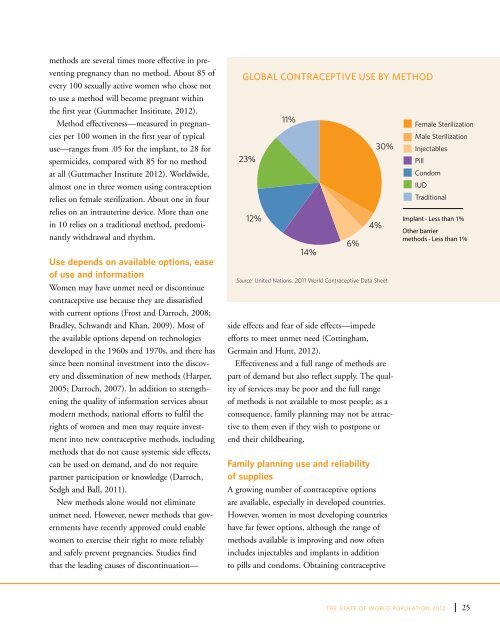State of World Population 2012 - Country Page List - UNFPA
State of World Population 2012 - Country Page List - UNFPA
State of World Population 2012 - Country Page List - UNFPA
Create successful ePaper yourself
Turn your PDF publications into a flip-book with our unique Google optimized e-Paper software.
methods are several times more effective in preventing<br />
pregnancy than no method. About 85 <strong>of</strong><br />
every 100 sexually active women who chose not<br />
to use a method will become pregnant within<br />
the first year (Guttmacher Insititute, <strong>2012</strong>).<br />
Method effectiveness—measured in pregnancies<br />
per 100 women in the first year <strong>of</strong> typical<br />
use—ranges from .05 for the implant, to 28 for<br />
spermicides, compared with 85 for no method<br />
at all (Guttmacher Institute <strong>2012</strong>). <strong>World</strong>wide,<br />
almost one in three women using contraception<br />
relies on female sterilization. About one in four<br />
relies on an intrauterine device. More than one<br />
in 10 relies on a traditional method, predominantly<br />
withdrawal and rhythm.<br />
Use depends on available options, ease<br />
<strong>of</strong> use and information<br />
Women may have unmet need or discontinue<br />
contraceptive use because they are dissatisfied<br />
with current options (Frost and Darroch, 2008;<br />
Bradley, Schwandt and Khan, 2009). Most <strong>of</strong><br />
the available options depend on technologies<br />
developed in the 1960s and 1970s, and there has<br />
since been nominal investment into the discovery<br />
and dissemination <strong>of</strong> new methods (Harper,<br />
2005; Darroch, 2007). In addition to strengthening<br />
the quality <strong>of</strong> information services about<br />
modern methods, national efforts to fulfil the<br />
rights <strong>of</strong> women and men may require investment<br />
into new contraceptive methods, including<br />
methods that do not cause systemic side effects,<br />
can be used on demand, and do not require<br />
partner participation or knowledge (Darroch,<br />
Sedgh and Ball, 2011).<br />
New methods alone would not eliminate<br />
unmet need. However, newer methods that governments<br />
have recently approved could enable<br />
women to exercise their right to more reliably<br />
and safely prevent pregnancies. Studies find<br />
that the leading causes <strong>of</strong> discontinuation —<br />
Global contraceptive use by method<br />
23%<br />
12%<br />
11%<br />
14%<br />
6%<br />
4%<br />
30%<br />
Source: United Nations. 2011 <strong>World</strong> Contraceptive Data Sheet<br />
side effects and fear <strong>of</strong> side effects —impede<br />
efforts to meet unmet need (Cottingham,<br />
Germain and Hunt, <strong>2012</strong>).<br />
Effectiveness and a full range <strong>of</strong> methods are<br />
part <strong>of</strong> demand but also reflect supply. The quality<br />
<strong>of</strong> services may be poor and the full range<br />
<strong>of</strong> methods is not available to most people; as a<br />
consequence, family planning may not be attractive<br />
to them even if they wish to postpone or<br />
end their childbearing.<br />
Family planning use and reliability<br />
<strong>of</strong> supplies<br />
A growing number <strong>of</strong> contraceptive options<br />
are available, especially in developed countries.<br />
However, women in most developing countries<br />
have far fewer options, although the range <strong>of</strong><br />
methods available is improving and now <strong>of</strong>ten<br />
includes injectables and implants in addition<br />
to pills and condoms. Obtaining contraceptive<br />
Female Sterilization<br />
Male Sterilization<br />
Injectables<br />
Pill<br />
Condom<br />
IUD<br />
Traditional<br />
Implant - Less than 1%<br />
Other barrier<br />
methods - Less than 1%<br />
THE STATE OF WORLD POPULATION <strong>2012</strong><br />
25
















